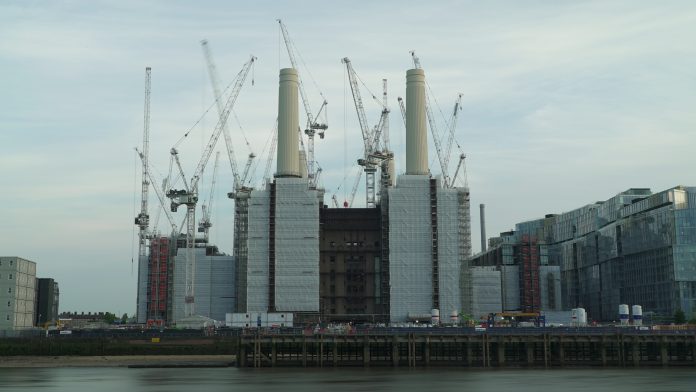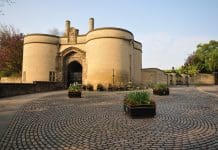BIM technology can help to unlock a more sustainable built environment while preserving and regenerating old buildings, says May Winfield, global director of commercial, legal and digital risks at Buro Happold
Technology is increasingly becoming an accepted and widely used staple for new construction projects. Technology tools can help anticipate risk, predict future performance and optimise a building’s energy efficiency. The benefits are huge, and the use of technology-led processes is becoming ever more ingrained into every stage of new build schemes.
When it comes to refurbishment or regeneration projects, however, the role of technology can sometimes be overlooked. As we collectively look at how we can create a more sustainable built environment and also preserve beautiful and important places, we need to recognise how technology can help us in this aim. This will become increasingly important to enable us to unlock more efficient and effective ways to deliver regeneration work.
Digitising information to improve decision-making when regenerating old buildings
Utilising technology for this can often start with something quite simple – enabling the collation of relevant information. Old buildings frequently do not have one central database of information that can be drawn upon. Data and designs are fragmented across a number of databases, plans and paper documents. Technology can allow us to collate and analyse this vast amount of data quickly in a way that has not been possible before.
Bringing this data together is firstly important because it can better inform the first decision to keep or demolish a building. Then if a decision is made to renovate the building, the data collated using surveys and laser scans can be used to create a digital representation of the building, often referred to as a digital twin. This is, admittedly, an easier process for new buildings but not impossible for regenerating old buildings using the tools now available.
The collated data and representations like a BIM model or digital twin can then provide a more comprehensive understanding of a building, enabling parties to work out the best methods of renovation, better-informing engineering and design decisions, as well as helping to understand project risk, likely costs and any reconstruction programme.
To take one example, at Battersea Power Station, the UK’s largest regeneration project, BIM technology was used to model the reconstruction plan and assess the risk of building so close to other projects, such as the Elizabeth Line extension. Arguably such a project would not have been possible without the use of such technologies.
However, using technology like BIM, digital twins and smart building technology in regeneration projects is not without its challenges. When creating a digital replica of old buildings or collating data regarding it, there is always an element of design or guesswork due to incomplete information. This is clearly a challenge, but it is ultimately worth the investment. Even though creating a model or digital twin for an older building can be difficult, you are investing in the future of old buildings. Informed decisions can be made about the best renovation processes, and once the digital model has been created, it can be continually updated across the lifespan of the building, making operation and any future retrofitting easier and more cost-effective.
Technology has become an important element of environmental sustainability
Without technology, you will have more limited data and understanding of the risks and possibilities and be unable to track the emissions efficiency or embodied carbon of a building. Some new build projects do already track emissions, but clearly, a building that is 20 or 30 years old was not designed with the technology to do so. Regenerating old buildings represents the perfect opportunity to install technology capable of enabling carbon efficiency through the use of various tools and processes, which is something that will be key as the built environment looks to meet ambitious net zero targets.
Installing this kind of sustainability-supportive and measurement technology arguably has three big benefits. At the most basic level, it gives you an understanding of what’s going on inside the building and, therefore, where emissions improvements can be made. Having that knowledge then allows you to both provide real-time data on building efficiency and then further optimise a building in the interests of sustainability. These benefits will only become more important with an increased push for renovation over demolishment, a global energy crisis and as more locations adopt carbon taxes.
Successful implementation of technology involves planning
It is, however, easy to adopt technology expecting it to be the simple solution or panacea. When designing and implementing technology, it’s important that clients consider what it is they want from the technology they’ve installed. Sometimes clients want to implement as much technology as possible with the expectation it will have particular long-term benefits. They can then be disappointed when this isn’t completely borne out once construction finishes and the building becomes operational.
There are also other factors to consider, including the security of data, accessibility of data and technology over time and the cost of upgrades or wastage as technology continually evolves.
In reality, successfully implementing technology is about working out from the outset how it can supplement and improve existing processes or replace them with better options. This can mean stepping back and understanding that technology is a valuable tool rather than a silver bullet that can solve all problems. At its heart, successfully implementing technology can mean determining what you want to achieve and then working back to determine which elements of technology tools and processes most suit these aims.
Regenerating old buildings is difficult and yet immensely important to create a more sustainable built environment. Where technology can make this job easier it should be wholeheartedly embraced, given the importance of regeneration to sustainability. That is not to say implementing technology for the sake of it, but where appropriate and with the correct planning and expertise.
Where this happens, it can guide intelligent design and engineering decisions to minimise risk, optimise a building’s energy efficiency and enable future renovation and regeneration to be undertaken much more effectively as we continue to pursue ambitious climate targets.
May Winfield
Global director of commercial, legal and digital risks
Buro Happold














